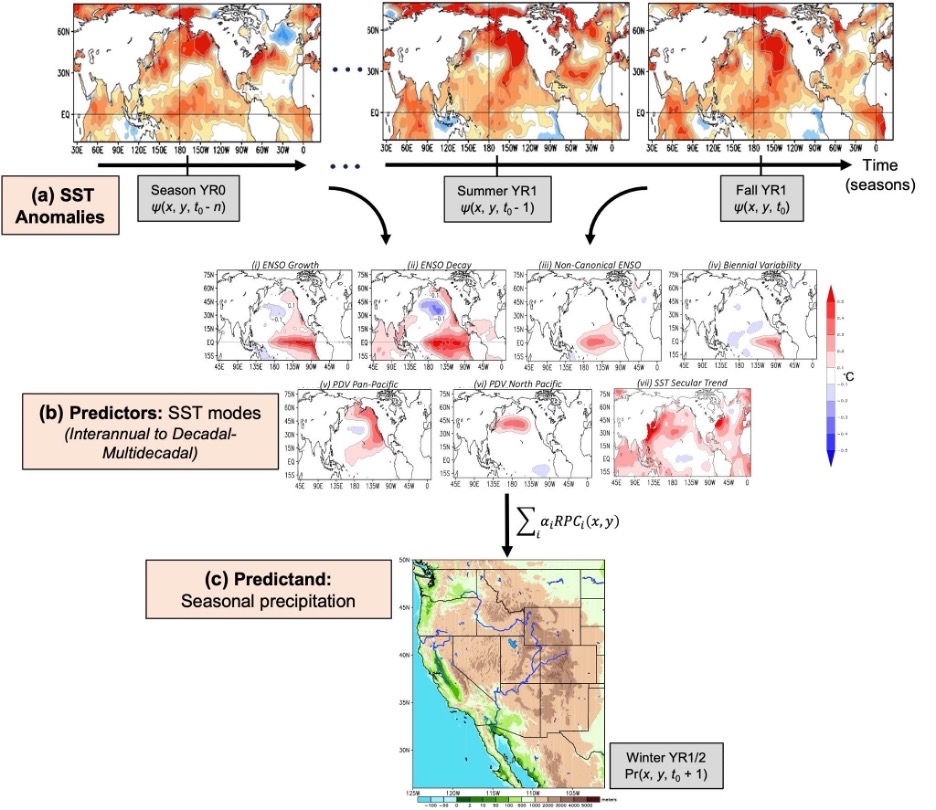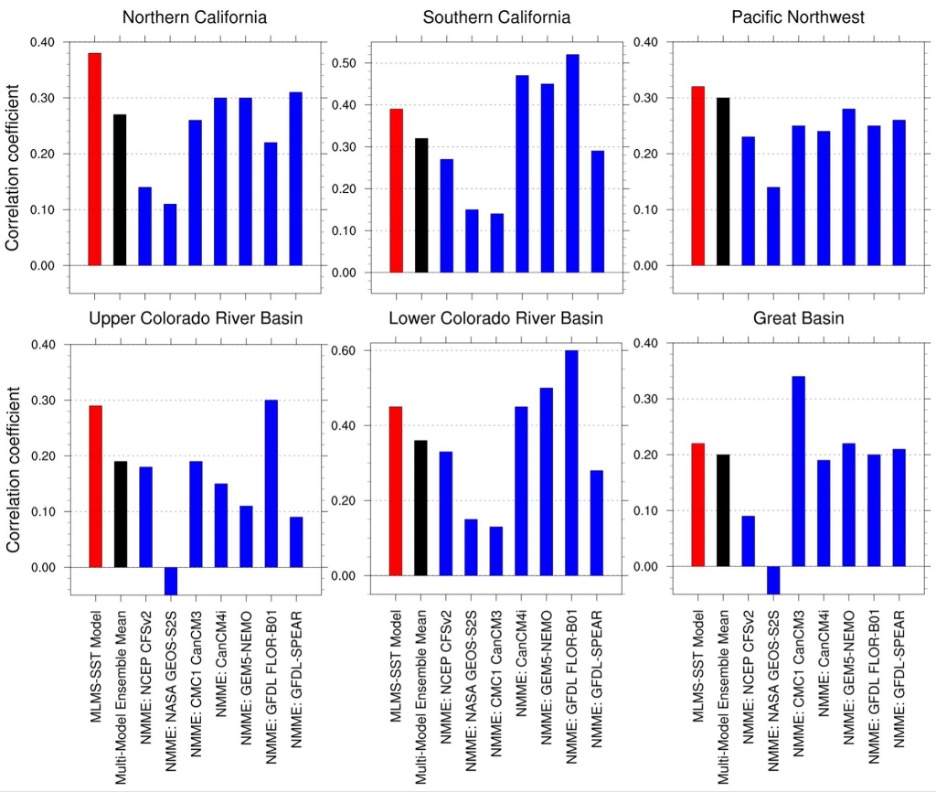CW3E Publication Notice
Role of evolving sea surface temperature modes of variability in improving seasonal precipitation forecasts
April 8, 2025
Scientists from the CW3E Subseasonal & Seasonal (S&S) Team recently published an article titled “Role of evolving sea surface temperature modes of variability in improving seasonal precipitation forecasts” in Nature Communications Earth & Environment. This study was led by Agniv Sengupta (CW3E) and co-authored by Duane E. Waliser (NASA Jet Propulsion Laboratory), Mike DeFlorio (CW3E), Bin Guan (UCLA), Luca Delle Monache, and F. M. Ralph (CW3E). This work aligns with CW3E’s goal to develop and leverage emerging technologies to improve the S&S precipitation prediction skill in the western United States. The work was supported by the California Department of Water Resources’ AR Program and National Aeronautics and Space Administration (NASA Grant 80NSSC22K0926).
The value of improving longer-lead precipitation forecasting in the water-stressed, semi-arid western United States cannot be overstated, especially considering the severity and frequency of droughts that have plagued the region for much of the 21st century. Multi-year droughts have been widespread in the state during the past decade, namely from 2012 to 2016 and from 2019 to 2022, which were relieved by the unprecedented storms of winter 2022–2023. Seasonal prediction skill of current operational forecast systems, however, remain insufficient for decision-making purposes across a variety of applications.
To address this capability gap, this study develops a Multi-Lead Multi-Source (MLMS) seasonal forecasting system that leverages the long-term memory of leading global and basin-scale modes of sea surface temperature (SST) variability (Figure 1). This approach focuses on characterizing and capitalizing on the spatiotemporal evolution of SST predictors from multiple antecedent seasons (Figure 1, panel a) instead of the customary use of predictive information from just the current season. This gives the ‘Multi-Lead’ or ‘ML’ part of the MLMS acronym. Another distinctive methodological feature is the incorporation of sources of predictability spanning multiple timescales from interannual to decadal-multidecadal (Figure 1, panel b), providing the ‘Multi-Source’ or ‘MS’ part of the MLMS acronym.
Figure 1. Schematic of the seasonal precipitation forecast methodology based on evolving SST modes of variability. Antecedent SST fields, Ψ (x, y), from multiple past seasons (t0, t0-1, t0-2, …, t0-n), illustrated in panel a, are projected onto predictor variables, shown in panel b, extracted from an extended-EOF analysis of observed SST anomalies. The derived modes of variability comprise natural variability ranging from interannual to decadal-multidecadal timescales as well as the secular trend. A statistical model is trained by leveraging the lagged relationships between these predictor modes and the predictand, which is precipitation anomaly, Pr (x, y), over the western U.S. in the following winter season (t0+1), shown in panel c. Figure 1 from Sengupta et al. (2025).
The results indicate that the seasonal forecast skill improves with the inclusion of more temporal lags in the predictor set. This finding validates our hypothesis concerning the importance of adequately capturing the spatiotemporal evolution of predictor variables from multiple past seasons, rather than relying solely on the most recent season’s data. Additionally, hindcast skill assessment of the MLMS forecast system’s performance demonstrates skill over core winter precipitation regions relative to dynamical and statistical baselines. Specifically, the model hindcasts are competitive with or superior to the North American Multi-Model Ensemble (NMME) dynamical models, particularly in Northern California, Pacific Northwest, and the Upper Colorado River basin (Figure 2).
Figure 2. Hindcast skill of MLMS-SST model compared with the NMME dynamical models and their multi-model ensemble mean over constituent HUC basins in the western U.S. The dynamical models assessed here include the NCEP-CFSv2, NASA GEOS-S2S, CMC CanCM3, CanCM4i, GEM5-NEMO, GFDL FLOR-B01 and GFDL-SPEAR, with hindcasts initialized in October for the November through March winter season. These dynamical models are shown in blue with their multimodel ensemble in black, and the proposed MLMS-SST model in red. The comparative assessment is performed for the common overlapping period of available hindcasts—winters 1982-83 through 2010–11 (with the exception of GFDL-SPEAR, available only from winter 1991-92). The correlations reported in each case are the area-averaged values computed over continental grid points. Figure 6 from Sengupta et al. (2025).
Our study offers a promising new approach for the potential improvement of seasonal precipitation forecasting, which has been defined as a top priority in the Weather Research and Forecasting Innovation Act passed by the 115th U.S. Congress as well as recognized internationally as a research priority by the World Meteorological Organization. The proposed methodology develops an experimental forecasting tool with the potential to support water and agricultural managers, as well as emergency response planners in California and the Colorado River Basin—an important source of imported water supplies—in making informed resource positioning and policy decisions, particularly at the onset of the winter season.
Sengupta, A., Waliser, D. E., DeFlorio, M. J., Guan, B., Delle Monache, L., & Ralph, F. M. (2025). Role of evolving sea surface temperature modes of variability in improving seasonal precipitation forecasts. Communications Earth & Environment, 6, 256. https://doi.org/10.1038/s43247-025-02235-y


